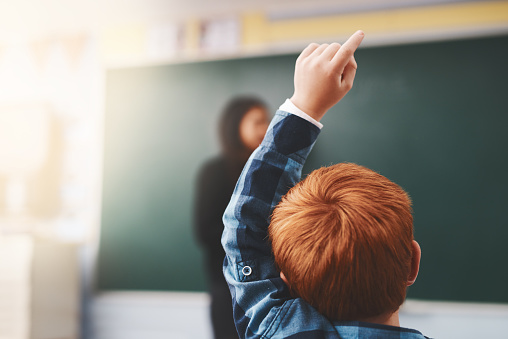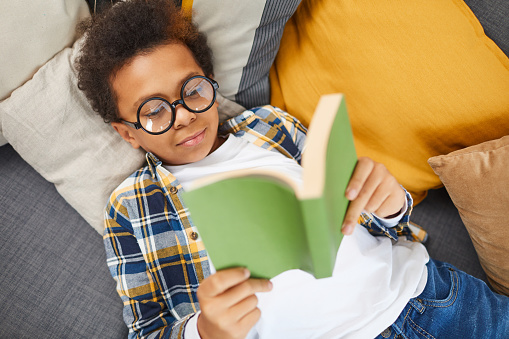
As an eye care professional, you know better than anyone how important vision is to learning. In fact, studies have shown that as much as 80% of what children learn in school is presented visually [1,2,7]. It is estimated that 1 in 4 school children have some form of vision problem. Of these, 5 to 10 percent have significant problems that, if left untreated, can affect their learning and development. Anything impacting a child’s ability to see clearly can also impact their ability to learn.
Good vision is essential for kids to be able to see the blackboard at school, read textbooks, and complete assignments. However, many parents don’t realize how vision impacts learning or how important it is to get their kids’ eyes checked on a regular basis. In this blog post, we’ll briefly explore how vision is related to learning and offer some tips on how you can get patients to understand the importance of getting an annual eye exam for their kids.
How Vision Impacts Learning
Poor vision can make it difficult for kids to process what they see. This can lead to poor grades and difficulty keeping up with their peers. If a child has undiagnosed binocular vision problems (eyes that don’t work together as a team), they may compensate by using only one eye at a time. This can even lead to headaches, double vision, and fatigue.

Learning-Related Vision Problems
Some of the most common symptoms of learning-related vision disorders are:
- Double vision, particularly during or after reading
- Poor handwriting
- Hyperactivity or recklessness during class
- Word and letter reversals
- Easily distracted during reading
- Poor reading comprehension
- Poor overall school performance
- Circumventing of reading
- Blurred vision, especially after reading or working closely
- Eye Strain or frequent headaches
Why Annual Exams are Important
During an annual comprehensive eye exam, you do more than just test for refractive error. There is also a screening for other common problems like amblyopia, strabismus, glaucoma, and more serious diseases such as cancer. You also take into account how the eyes are working together as a team.
Many vision problems can easily go undetected in young children. That’s because children don’t always know to tell their parents if they’re having trouble seeing. The kids might not even realize they’re having problems because they’re vision is all they know and they don’t realize it should be better. As a result, vision problems can lead to delays in development and learning and these delays can be hard to come back from. Additionally, some vision problems can worsen over time if they’re not treated early on.
How Poor Vision Can Lead to Delays
A recent study from Johns Hopkins [8] on the difference glasses make for children in school displays how beneficial they can be for learning. The research was conducted with 7,000 children from various schools in Baltimore and is considered to be one of the largest controlled studies done in the U.S. Those who seemed to gain the most academic improvement were students that generally need more help academically or those with disabilities–demonstrating improvements equal to four to six months of learning.

What’s less well known is how difficult it can be to catch up on those delays once they’ve occurred. Much of what is taught in school builds upon previous concepts, so if a child has missed out on key ideas, it can be very difficult for them to understand what is being taught later on. In addition, children who have fallen behind often struggle with confidence and motivation; they may feel like they can never catch up.
Tips for Getting Patients to Understand the Importance of Annual Eye Exams
Explain how vision impacts learning – Many parents don’t realize how important vision is to learning. By explaining how poor vision can impact their child’s ability to see the blackboard, read textbooks, and write neatly, you’ll help them understand why it’s so important to get their kids’ eyes checked on a regular basis.
Vision affects a student’s ability to pay attention.
There is a direct connection between what a student sees and how well they are able to pay attention in school [9]. If a student struggles with visual processing or has a hard time tracking words on a page, they are likely to have difficulty paying attention in class. Conversely, if a student has clear vision and 20/20 eyesight, they will be more likely to be able to focus on their work and pay attention in class.
Good vision is necessary for proper hand-eye coordination.
Hand-eye coordination is important for many tasks such as writing, cutting with scissors, and throwing a ball. If a child lacks good hand-eye coordination, they may have difficulty completing these tasks—and may consequently struggle in school. Poor hand-eye coordination can also lead to poor fine motor skills, which can make it difficult for children to write properly or do other tasks that require the use of small muscles.
Vision problems can impact a child’s social development.
Children who have trouble seeing clearly may avoid social situations because they are embarrassed about their vision problem or because they struggle to keep up with their peers visually. As a result, they may have fewer friends and miss out on important social development opportunities.
Tips to get patients to make an appointment
Remind and incentivize – Most insurance plans offer a free annual exam. Remind your patients of these benefits via email. Offering free or discounted exams is a great way to get parents in the door. Once they’re in for an exam, you can provide them with more information about the importance of annual eye exams and answer any questions they may have. Remember parents are busy. So make it easier for them by sending reminders.
Give clear instructions – Be sure to give parents clear instructions on what they need to do in order to prepare their child for their appointment (e.g., no screens two hours before the appointment, etc.). This will help ensure that the exam goes smoothly and that you’re able to get an accurate assessment of your child’s vision.
Follow up after the appointment – Don’t forget to follow up after the appointment. Thank parents for bringing their child in. You could even send them a reminder card in the mail before their next scheduled appointment.
It is important for parents to be proactive in ensuring their children’s vision health. Annual eye exams are an important part of this, and by explaining the importance of these exams to patients, you can help them understand why it’s so important to bring their kids in for a check-up. Additionally, remind parents that most insurance plans offer free annual exams, so there’s no reason not to get your child’s eyes checked on a regular basis. And finally, follow up with parents after the appointment to thank them for bringing their child in and answer any questions they may have.
To find out more about becoming a ZEISS customer, please click here.
To find an eye doctor near you please visit www.zeiss.com/FindAnEyeDr
References
1) Wang S, Hao X, Ma X, Yu Y, Wu L, Wang Y, Li Y. Associations between Poor Vision, Vision-Related Behaviors and Mathematics Achievement in Chinese Students from the CNAEQ-PEH 2015. Int J Environ Res Public Health. 2020 Nov 18;17(22):8561. doi: 10.3390/ijerph17228561. PMID: 33218140; PMCID: PMC7698834.
2) Dudovitz RN, Izadpanah N, Chung PJ, Slusser W. Parent, Teacher, and Student Perspectives on How Corrective Lenses Improve Child Wellbeing and School Function. Matern Child Health J. 2016 May;20(5):974-83. doi: 10.1007/s10995-015-1882-z. PMID: 26649878; PMCID: PMC4826825.
3) Atowa UC, Wajuihian SO, Hansraj R. A review of paediatric vision screening protocols and guidelines. Int J Ophthalmol. 2019 Jul 18;12(7):1194-1201. doi: 10.18240/ijo.2019.07.22. PMID: 31341813; PMCID: PMC6629797.
4) CDC. (2010). Building a basis for action: Enhancing public health surveillance of visual impairment and eye health in the United States. Atlanta: Centers for Disease Control and Prevention
5) Egerter, B., Sadegh-Nobarl, T., Grossman-Kahn, R., & Dekker, M. (2009). Issue brief 8: Education and health. In Robert Wood Johnson Foundation Commission to Build a Healthier America (pp. 1–15). http://www.rwjf.org/content/dam/farm/reports/issue_ briefs/2011/rwjf70447
6) Krumholtz, I. (2000). Results from a pediatric vision screening and its ability to predict academic performance. Optometry (St. Louis, Mo.), 71(7), 426–430.
7) Yawn, B. P., Lydick, E. G., Epstein, R., & Jacobsen, S. J. (1996). Is school vision screening effective? Journal of School Health, 66(5), 171–175. doi:10.1111/j.1746-1561.1996.tb06269.x.
8) Neitzel AJ, Wolf B, Guo X, et al. Effect of a Randomized Interventional School-Based Vision Program on Academic Performance of Students in Grades 3 to 7: A Cluster Randomized Clinical Trial. JAMA Ophthalmol. 2021;139(10):1104–1114. doi:10.1001/jamaophthalmol.2021.3544
9) Maunsell JH, Cook EP. The role of attention in visual processing. Philos Trans R Soc Lond B Biol Sci. 2002 Aug 29;357(1424):1063-72. doi: 10.1098/rstb.2002.1107. PMID: 12217174; PMCID: PMC1693016.
Leave a Reply